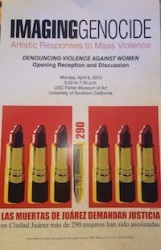 Although most people picture museums as quiet places, one exhibit at the USC Fisher Museum of Art is breaking the sound barrier to end the silence around violence against women.
Although most people picture museums as quiet places, one exhibit at the USC Fisher Museum of Art is breaking the sound barrier to end the silence around violence against women.
Women survivors of the Holocaust can be heard sharing their stories as part of the Denouncing Violence Against Women exhibit, which began April 8.
The exhibit showcases art that has emerged as a response to violence against women in places such as Armenia, Congo, Guatemala, Rwanda, and Mexico. USC students curated the exhibit as part of an art history class taught by Dr. Selma Holo, USC art history professor and Fisher Museum director.
The exhibit consists of two parts. The first displays video testimonials from Holocaust survivors provided by the USC Shoah Foundation. Curators Michelle Crisosto, Lauren Dodds, Helena Liikanen-Renger and Ambra Spinelli, selected these testimonials from the 52,000 housed at the foundation.
The second part of the exhibit displays 18 posters collected from the Center for the Study of Political Graphics. Selma Holo thinks these posters are one of the most unique aspects of the exhibit.
“We try to make it look as if these are posters that could be on the wall in Mexico or in China,” Holo said. “We are honoring the fact that these are public works of art, not private works of art.”
Although Holo guided her students, they produced the exhibit on their own.
The curators categorized the images into four groups: Dehumanization, Individuality, Trauma, and Breaking Bonds.
USC student curator Lauren Dodds said she finds some of the posters in the dehumanization section particularly moving.
This group of posters focuses on the murders of women in Juarez, a Mexican town where almost 300 unidentified women were murdered and 500 went missing in the early 1990s.
The exhibit’s main image used for fliers came from this group of images. Tubes of lipstick frame a bullet with the number 290 above it, representing the 290 unidentified dead bodies found in Juarez.
These images were designed by Mexican artists a decade after these events in an attempt to raise awareness.
The exhibit addresses genocides and mass killings, such as those in Juarez, as part of USC’s larger Genocide Awareness Week.
It also addresses issues such as genital mutilation, domestic violence, and prostitution. Curator Michelle Crisosto explains this strategic selection.
“One important aspect was choosing images that covered a diverse range issues relating to violence against women,” Crisosto said. “This really emphasizes the expansiveness of violence against women. These things are not happening in just one place in the world or in just one form.”
While the images may be somewhat jarring, curators hope viewers leave with a positive message.
“I hope viewers will walk away from the exhibition with an empowered sense of how they could use a variety of media to speak out against violence,” Dodd said.
The Fisher Museum will display the exhibit until April 21.















Speak Your Mind